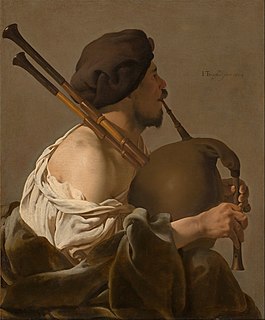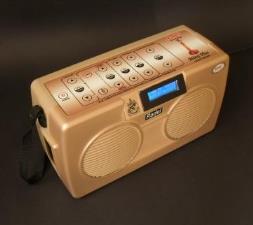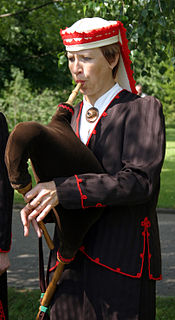
Bagpipes are a woodwind instrument using enclosed reeds fed from a constant reservoir of air in the form of a bag. The Scottish Great Highland bagpipes are the best known in the Anglophone world; however, bagpipes have been played for a millennium or more throughout large parts of Europe, northern Africa, and western Asia, including Turkey, the Caucasus, and around the Persian Gulf. The term bagpipe is equally correct in the singular or plural, though pipers usually refer to the bagpipes as "the pipes", "a set of pipes" or "a stand of pipes".

Carnatic music, Karnāṭaka saṃgīta, or Karnāṭaka saṅgītam, is a system of music commonly associated with southern India, including the modern Indian states of Andhra Pradesh, Telangana, Karnataka, Kerala, and Tamil Nadu, as well as Sri Lanka. It is one of two main subgenres of Indian classical music that evolved from ancient Hindu traditions, the other subgenre being Hindustani music, which emerged as a distinct form because of Persian or Islamic influences from Northern India. The main emphasis in Carnatic music is on vocal music; most compositions are written to be sung, and even when played on instruments, they are meant to be performed in gāyaki (singing) style.

The chanter is the part of the bagpipe upon which the player creates the melody. It consists of a number of finger-holes, and in its simpler forms looks similar to a recorder. On more elaborate bagpipes, such as the Northumbrian bagpipes or the Uilleann pipes, it also may have a number of keys, to increase the instrument's range and/or the number of keys it can play in. Like the rest of the bagpipe, they are often decorated with a variety of substances, including metal (silver/nickel/gold/brass), bone, ivory, or plastic mountings.

The Great Highland bagpipe is a type of bagpipe native to Scotland. It has acquired widespread recognition through its usage in the British military and in pipe bands throughout the world.

Zampogna is a generic term for a number of Italian double chantered pipes that can be found as far north as the southern part of the Marche, throughout areas in Abruzzo, Latium, Molise, Basilicata, Campania, Calabria, and Sicily. The tradition is now mostly associated with Christmas, and the most famous Italian carol, "Tu scendi dalle stelle" is derived from traditional zampogna music. However, there is an ongoing resurgence of the instrument in secular use seen with the increasing number of folk music festivals and folk music ensembles.

A shruti box is an instrument, originating from the Indian subcontinent, that traditionally works on a system of bellows. It is similar to a harmonium and is used to provide a drone in a practice session or concert of Indian classical music. It is used as an accompaniment to other instruments and notably the flute. The shruti box is also used in classical singing. In classical singing, the shruti box is used to help tune the voice. The use of the shruti box has widened with the cross-cultural influences of world music and new-age music to provide a drone for many other instruments as well as vocalists.

The pungi, also called the been (बीन) and murli, is a wind instrument played by snake charmers on the Indian subcontinent. The instrument consists of a mouth-blown air reservoir made from a gourd, which channels air into two reedpipes. The pungi is played with no pauses, with the player employing circular breathing. The pungi originated in India and is still played by snake charmers in street performances.
In music, a drone is a harmonic or monophonic effect or accompaniment where a note or chord is continuously sounded throughout most or all of a piece. The word drone is also any part of a musical instrument that is used to produce such an effect, as is the archaic term burden such as a "drone [pipe] of a bagpipe", the pedal point in an organ, or the lowest course of a lute. Α burden is also part of a song that is repeated at the end of each stanza, such as the chorus or refrain.

The term double clarinet refers to any of several woodwind instruments consisting of two parallel pipes made of cane, bird bone, or metal, played simultaneously, with a single reed for each. Commonly, there are five or six tone holes in each pipe, or holes in only one pipe while the other acts as a drone, and the reeds are either cut from the body of the instrument or created by inserting smaller, slit tubes into the ends of the pipes. The player typically uses circular breathing.

The Sarasvati vīṇa is an Indian plucked string instrument. It is named after the Hindu goddess Saraswati, who is usually depicted holding or playing the instrument. Also known as raghunatha veena is used mostly in Carnatic Indian classical music. There are several variations of the veena, which in its South Indian form is a member of the lute family. One who plays the veena is referred to as a vainika.

Welsh bagpipes The names in Welsh refer specifically to a bagpipe. A related instrument is one type of bagpipe chanter, which when played without the bag and drone is called a pibgorn (English:hornpipe). The generic term pibau (pipes) which covers all woodwind instruments is also used. They have been played, documented, represented and described in Wales since the fourteenth century. A piper in Welsh is called a pibydd or a pibgodwr.

An electronic tanpura is an electronic instrument that replicates the sound of an Indian string instrument known as the tanpura (tambura), used to provide a constant drone to accompany another's vocal or instrumental melody.

The torupill is a traditional bagpipe from Estonia.
Śruti is Hindu sacred texts. Śruti is a Sanskrit word that means "thing heard" or "sound". It may refer to:
The Loh Tarang is a melodic percussion instrument. It consists of a set of iron circular plates, of different sizes, held in a frame. Each plate is pitched to a note and they are struck with sticks on each hand. 'Tarang' literally means waves. Plates sound depends on the different size of plate and hand movement. Theory is based like Jal-Tarang.
The ottu is a double reed wind instrument, used in Carnatic music of Southern India to provide a drone accompaniment to the similar nadaswaram oboe. Like the nadaswaram, the ottu is a large conical instrument, some two and a half feet long. Unlike the nadaswaram, the ottu has no fingerholes, being intended to produce one constant note while playing. It is provided with several small tuning holes which can be stopped with wax to modify its note. In some cases, a shruti box may be used in place of the ottu due to its steadier sound. The player holds the instrument in their left hand, sustaining the sound by inhaling through their nose, and with the right hand, beats on a drum strapped onto a belt.












